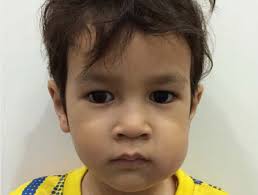Mumps: Painful swelling on one or both sides of the cheeks of a child’s face.
Causes of painful swelling on one or both sides of the cheeks of a child’s face.
1. Mumps
2. Dental abscesses
3. Trauma/fall
4. Allergy /Anaphylaxis/angioedema
5. Cushing syndrome
6. Salivary glands tumour (rare in children)
7. Burkitt lymphoma
8. Bone tumour
9. Chronic Liver disease
10 Malnutrition
11. embryonal rhabdomyosarcoma
12. Kidney problem (Nephrotic syndrome)
The commonest cause of one or both sided facial swelling in child is mumps. 👇
Mumps is a systemic viral infection characterized by swelling of the one or more of the salivary glands usually the parotid glands. Mumps infection is endemic worldwide and peaks at 5-9 years of age.
Vaccination has reduces the incidence in children but incomplete coverage and waning immunity with time have led to outbreaks in young adults. Infection has spread by respiratory droplets.

Mumps infection are usually acute and self limiting but requires aggressive treatment because some males with mumps may find it difficult to impregnate a woman in their adult life.
Causative Organism of mumps
The illness is caused by the RNA virus, Rubulavirus. Rubulavirus is within the genus Paramyxovirus and is a member of the family Paramyxoviridae.
HISTORY
December 1967, the Advisory Committee on Immunization Practices (ACIP) recommended that its use should be considered for children nearing puberty, for adolescents, and for adults 1977, routine vaccination was recommended for all children age 12 years and older.
1980, further recommendations called for mumps vaccination of susceptible children, adolescents, and adults, unless it was medically contraindicated.
In 1989, the ACIP recommended that designated MMR (measles mumps rubella) as the vaccine of choice.
Transmission
Humans are the sole reservoir for the mumps virus. The transmission mode is person to person via respiratory droplets and saliva, direct contact, or fomites.
The presence of maternal antibodies typically protects infants younger than 12 months old from the disease. Infections can be a symptomatic in 20-30% of persons.
Of those with symptomatic infection, adults tend to be more severely affected when compared to children. Infants born to mothers who have had mumps a week prior to delivery, may have clinically apparent mumps at birth or develop illness in the neonatal period.
How do you know you have mumps – Symptoms
➡️Incubation period of 16-18 days; however, cases can arise 12-25 days after exposure.
➡️Prodromal symptoms (last 3-5 days after incubation period): low-grade fever, malaise, myalgia, headache, and anorexia.
➡️Classical tender parotid enlargement which in 75 percent of the times on both sides of the face. In 25 percent of children or adults, cheek swelling as a result of mumps is on one side of the face.
➡️Headaces
➡️Painful and swollen sides of the face
➡️Fever
➡️Chills
➡️Neck pain
Complications
1. The most common presentation is a parotitis, which occurs in 30 to 40% of all patients and in 95% of those who are symptomatic. Parotitis is caused by direct viral infection of the ductal epithelium and presents with localized gland inflammation.
2. Other sites for infection:
➡️central nervous system (CNS): encephalitis
eyes- hearing loss, convulsions.
➡️Pancreas – pancreatitis
➡️Kidneys – nephritis
➡️testes – orchitis (is the most common complication of mumps infection in adult male)
➡️Abortion may occur if mumps infection takes place in the first trimester or pregnancy.
Treatment
Treatment is with painkillers to relief pain and fever. There us is evidence that that costicosteroids are beneficial. Mumps should not be treated at home, please take your child to see a doctor.
Prevention
The mumps vaccine is usually given as a combined measles-mumps-rubella (MMR) inoculation. It is the safest and most effective form of each vaccine.
Two doses of the MMR vaccine are recommended before a child enters school. It is given between the ages of 12 and 15 months
Side effects of the vaccine
Most people experience no side effects from the vaccine. Some people experience a mild fever or rash or achy joints for a short time.
CAVEAT: Since mumps is very contagious, keep your child away from others for at least five days after their glands start to swell.
Written by Dr Murphy-Akpieyi ofeoritse
Featured Image: Malaysian Dental Association























